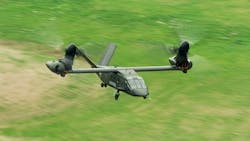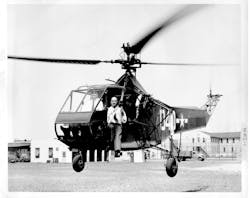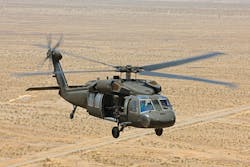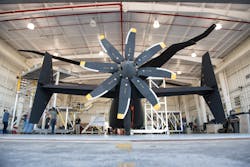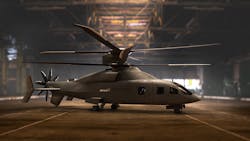By Megan Crouse
NASHUA, N.H. - Developing a new generation of advanced helicopters is a long process. Customer requirements and available technologies are changing all the time, while the work itself is time-consuming. With projects starting in the last few years targeting a 2030 operational date, how do today’s designers and builders define ‘advanced’?
Today’s designers are working on giving military designers what they’re asking for: helicopters of the future that can fly faster, lower, and with more agility than these rotorcraft can today.
They’re also intended to be quieter — physically and in terms of their electronic signatures. Enhanced navigation and guidance will improve acquisition and satellite navigation performance. Tomorrow’s aircraft will use the best of both worlds when it comes to helicopter and airplane technology.
A brief history of helicopters
Flying machines using rotors have been the subject of engineering curiosity and achievement since the 1700s. Jules Verne used them in his fiction before theyWhen German progress on helicopters in World War II encouraged Congress to contribute U.S. federal money to helicopter development, the race was on. Radar consideration was a concern at the same time as flight time was being improved and prohibitive vibrations smoothed out. Companies around the world, including French, British, and South African, also worked on creating what would become the groundwork for the modern helicopter in the 1960s.
The first U.S. production helicopter, Igor Sikorsky’s brain child the XR-4, sold to the U.S. and British militaries. This marked the beginning of the modern era, but this age of invention also generated its spinoffs. Vertical takeoff and landing vehicles and the idea of a working ‘jet pack’ using helicopter technology still have a sheen of the futuristic around them today, even as they remain mostly in the realm of novelty. These were also of interest to the military in the ‘40s and ‘50s.
The Black Hawk
In the 1970s, the Black Hawk emerged on the scene. Commissioned to replace the UH-1 Iroquois helicopter, otherwise known as the Huey, the UH-60A Black Hawk entered Army service in 1979. Since then, it has been involved in almost every major Army operation. As a medium-lift, multi-role helicopter, its versatility explains some of its enduring popularity. Over the years, improvements were made to the original, including an improved turbine engine, upgrades to the airframe to increase crash worthiness, and a lighter, composite all-moving tail.
The Army holds about 2,100 UH-60 Black Hawks in inventory in the contemporary era, with multiple versions. They’re likely to stay in service in some capacity until at least 2054, according to an Army post on the occasion of the platform’s 40th anniversary.
Despite this longevity and record of performance, Black Hawks are getting old, and that’s hitting their use in civil operations. Some civil aviation companies buy dozens for parts just to keep a few in their fleets working. As of December 2021, new production S-70M Black Hawk helicopters in the latest configuration now have Federal Aviation Administration ratings, meaning they’re available for select commercial operators to buy right off the line.
Fly-by-wire
As in the urban air mobility space, some experimentation has been done with automated robotic helicopters, and the Black Hawk in particular has been the focus for an Army initiative to deploy a fully uncrewed vehicle like this, with no backup pilots. Experts at the U.S. Defense Advanced Research Projects Agency (DARPA) say they plan to demonstrate the solo UH-60 in as early as this month.
The end goal is to allow the ‘autonomous brain,’ the Aircrew Labor In-Cockpit Automation System, to fly one its own without backup pilots for safety and oversight. This has the obvious advantage of not putting crew members in danger, for example, on missions to fly supplies to other troops already under fire.
There has also been some chatter about what Maj. Gen. Walter Rugen, head of the Army’s Future Vertical Lift Cross Functional Team (FVL CFT) called “optimally manned.” That means the vehicle would have a human pilot or pilots, but those people would be able to turn their attention to particular tasks necessary for optimal efficiency.
Twice as far, twice as fast
The leading American military helicopter today remains the Black Hawk, which has held the top spot for more than 40 years. Now, Army planners are aiming for areplacement by 2030. To find it, they gave two requests for proposals for the Future Long-Range Assault Aircraft (FLRAA) program to the giants of the helicopter world. This program itself is part of the broader Joint Multi-Role Technology Demonstration, or JMR-TD, an acquisitions push for next-generation capabilities supported by both the Army and industry partners.
These requests outline what the Army means by advanced.
“FLRAA will have increased speed, range, and survivability to overmatch enemy forces in contested and ever-changing environments,” Army officials say. The plan is for Army combat aviation brigades to roll the chosen vehicles out in 2030.
The chosen design will need to clock with an objective cruise speed of 280 knots, or roughly 320 miles per hour and to maintain 100 percent maximum continuous power. It must carry as many as 12 passengers, endure flying at 6,000 feet in 95-degree heat, and fly roughly 1,725 nautical miles one-way without refueling. Another requirement is the ability to perform a 500-foot per minute vertical rate of climb. The selected aircraft also must include medical evacuation capabilities.
“The Army aviation’s vision necessitates next-generation vertical lift capabilities that can deter, fight, and win as part of the joint force, in increasingly dangerous and complex environments,” Army officials say.
Other advancements being discussed in military and consumer spaces include more automated fly-by-wire capabilities, and improvements in manufacturability and sustainability.
The V-280 Valor
To get their contender off the ground, Bell Textron Inc. in Fort Worth, Texas, had a good precedent on which to look back: the Bell Boeing V-22 Osprey. This aircraft, which in part inspired Bell’s FLRAA entry, also was a tiltrotor vehicle. The V-22’s range of 860 nautical miles and speed of 266 knots shows the kind of performance improvements being made between generations.
While the tiltrotor itself is far from a brand-new concept (the V-22 took its first flight in 1989 and served in Iran and Afghanistan), Frank Lazzara, director of sales and strategy for Future Long Range Assault Aircraft at Bell, says this half-airplane, half-helicopter concept still is the right direction for the agility and stability a next-generation aircraft needs.
Lazzara described the meaning of ‘advanced’ today as “Higher performing, further, faster more efficiently; has greater availability, easier to work on, requires less maintenance … adhering to the Army’s modern open systems approach is advanced. That would essentially net, down the road after the aircraft is fielded, an easier path to upgrade the aircraft quicker. It would also keep the market competitive.”
A modular open systems approach (MOSA) and fly-by-wire still are considered advanced and in development.
Another challenge is “Can you do this at a reasonable cost? Can you do this and ensure a good sustainment, a good sustainability percentage? Do you have good ways to maintain aircraft tools derived from the digital thread technology?” Lazzara says.
As far as tiltrotors go, the V-280 has several elements that make it an improvement on the V-22 as far as taking advantage of the hybrid wing-rotor design. One requirement of FLRAA was that it will be able to fit in roughly the same size landing zones as the Black Hawk, which necessitates the V-280 be smaller than the V-22. In addition, Bell has given it increased agility in the prop rotor system and faster response.
The tiltrotor and wing setup means that the aircraft has the agility of a machine with a wing, but the hovering and vertical landing capabilities of a helicopter.
“There’s also tactical or operational or strategic agility,” Lazzara points out. “The way you can now plan missions so you can fly further, faster, do it very efficiently and does not sacrifice the high speed… The tiltrotor can get to that target and when it gets there function at low speed.”
Put simply, this design brings the best of both worlds, Lazzara says. “Pure rotor craft also have a lot of drag, and you have to overcome drag with power. Whereas when you fly on a wing it’s a very efficient way to create lift.”
More adjustable rotors also mean more ways to cut down on audible noise. V-22 and V-280 demonstrations could show this very dramatically, Lazzara says. “We would talk to a crowd and talk about how quiet the aircraft was and it would come up behind them and they wouldn’t have noticed.”
That’s because of the direction in which the noise travels. “The noise you hear from a helicopter comes from two things: one is the tail rotor. You have a small rotor that’s spinning very, very fast. The second thing is the main rotor,” Lazzara says. “As the main rotor turns, noise is propagated edgewise. Where the tips of the blades are, the noise goes in that direction. … In a tiltrotor you have the same edgewise noise but the direction at which it is projected is basically reconfigurable or different. When it’s in helicopter mode the noise goes out … but when you bring the pylons down so the prop rotors become propellers, now that noise is going out to the side and behind, and because of the speed of the aircraft the aircraft is out in front of the noise.”
To return to the idea of digital, Lazzara emphasizes that while Bell is far from the only company to include today’s interactive, 3D digital models in the design-for-manufacturability stage, its approach has a very specific angle. They design for a less linear manufacturing process. If the aircraft can’t pass through one particular station because a part isn’t in yet, someone else can work on it without disrupting the schedule.
They also used the a shared digital space to do walkthroughs with the stakeholders who are actually going to be working on and using the aircraft. Maintainers do virtual walkthroughs at the design stage of the procedures they can expect to perform on the aircraft in the field.
“Not only the primary designers but the Valor teammates in our case or even suppliers can function in the design space,” Lazzara says.
As a former V-22 pilot, Lazzara sees that while they are both based on the tiltrotor, the V-280 is a leap forward. “Not only it will be able to perform superbly right away, but it’s going to have a long-term value. The aircraft is not going to get bogged down by upgrades and changes,” he says.
Defiant X
Black Hawk parent company Sikorsky, a Lockheed Martin company in Stratford, Conn., is working together with the Boeing Co. on a prototype on the metaphorical runway that might be posed to take the FLRAA spot, Defiant X.
“Defiant or the FLRAA competition is really designed to be the next aircraft after the Black Hawk in the long-range assault role and this aircraft really delivers, itgoes twice as far, twice as fast and twice the capability,” says Jay Macklin, Sikorsky business development director, Future Vertical Lift.
The SB>1 DEFIANT, the technology demonstrator for the Defiant X weapons system, boasts speed as fast as 230 knots in level flight, according to a Lockheed Martin promotional feature. It also demonstrated lifting an external load of 5,300 pounds, with use cases including carrying rations, medical supplies or weapons systems into otherwise hard-to-reach or contested areas. Boeing clocked the Defiant X at 247 knots in level flight and 50 knots in side flight.
“DEFIANT X is a fly-by-wire aircraft and has a very responsive rigid rotor system, which simplifies performance and increases responsiveness, helping DEFIANT X respond to control inputs more like a fighter jet than a helicopter,” says Heather McBryan, Boeing business development director, Future Vertical Lift. “DEFIANT X also has exceptional power margins that enable rapid acceleration and directional changes. The propulsor adds a third dimensional element which enables acceleration and deceleration along the longitudinal axis.”
Defiant X was made with a compound co-axial rotor system and pusher prop to reach the required maneuverability, which itself adds to survivability.
“We designed Defiant X to excel in arenas … which require a precise combination of speed and agility,” says McBryan. “The propulsor on the back of the aircraft plays a large role in that. Approaching the objective, Defiant X can engage the prop on the back of the aircraft for max speed and can disengage as needed for a quieter approach (the aircraft can still maintain 150 knots without the prop) – all while getting to the landing zone safely and quickly. Fly-by-wire controls, rigid main rotor and hover power also enable high agility for safer operations in complex environments.”
This is all part of what they’re calling X2 technology, a rotor setup and combination of different systems designed for a single-engine, single-pilot aircraft with improvements on vibration reduction, weight reduction and blade technology from previous models.
To address blade stall, the “dual coaxial rotor design has two rotor blades rotating in opposite directions, so there is an advancing blade on both sides of the aircraft which reduces the effects of retreating blade stall,” Macklin says. “Defiant X also has that propulsor on the tail of the aircraft to provide significant forward thrust to achieve very high speeds.”
As far as automatic systems go, Defiant X includes a built-in optionally piloted flight control system, designed to make the most of safety and effectiveness in “lowOther operational advantages exist at the intersection of agility and speed. In regards to radar detection and audible noise, McBryan says “The ability of Defiant X to maintain speed below radar is a stealth feature that we designed into the aircraft, and continue to validate in flight test. We also fly with and without the propulsor engaged to help manage acoustic footprint based on the environment.”
Like the Bell team, the Defiant X design was produced with the idea of digital thread for better manufacturability, interoperability and maintenance. The idea is that the digital mapping will be able to provide predictable “maintenance-free operating periods,” reducing the amount of work and money that goes into upkeep. The team also kept in mind that this needed to be put in place while not requiring the customers to invest in rebuilding any additional infrastructure. Instead, Sikorsky used their extensive military customer experience to make sure the new design fits within existing U.S. Army aviation support infrastructure.
“These tools enable analysis and optimization of component capability at much higher levels of fidelity than were employed on previous helicopters, reducing weight and cost,” says Macklin. “Finally leveraging the synergy between our digital design tools and manufacturing techniques such as metal and composite additive manufacturing offers the ability to develop and manufacture parts with revolutionary structures and capabilities that are unique and superior to legacy components.”
Macklin also points out that “the idea of semi-autonomous flight is not new to the military,” although it “figures to have even more relevance in the future as missions get more complicated.”
“This transformational technology [as shown with the Defiant technology demonstrator so far] will change the way that the Army conducts large scale air assaults from significant operational distances,” says McBryan. “That’s why we chose this design, and why we’ll continue to refine it as the Army gets closer to making its decision on the FLRAA competition.”
You might also notice another project often spoken about in the same breath as this one, Raider X. While Defiant X is made specifically for FLRAA, the Raider X attack craft fulfills the specifications for another Army prototype competition, Future Attack Reconnaissance Aircraft (FARA).
Other projects
While the FLRAA provides a good look at what is considered ‘advanced’ in military helicopters today, the two companies propositioned for it are of course not theNaturally, the Air Force has its own efforts, with Boeing delivering a new model Apache helicopter — the version known as AH-64E v6 — to U.S. Air Force customers in February 2021.
Customer connection
Lazzara also noted that relationships with customers are changing. The customer is now more likely to tell the OEM what they need instead of the other way around. For Bell, which hasn’t worked this closely with the military in some time, the philosophy is to go to the customer and listen, Lazzara says.
“We’re going to listen. We’re going to develop trust again with you,” he says.
